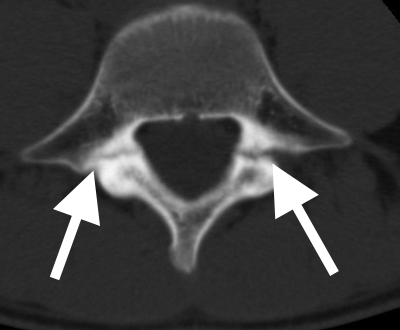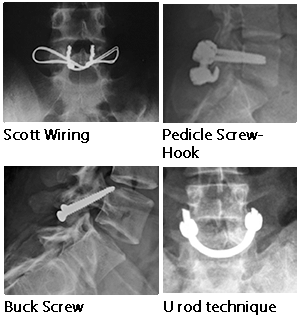- Home
- Patient Area
- Spondylolysis
What is spondylolysis?
 This is when part of the bone in the spine develops a crack in it. It is most commonly believed to be a stress fracture that occurs in childhood during growth and activity. Sometimes the fracture heals without further trouble. Sometimes it heals in an elongated shape and sometimes it remains as a gap. This can then cause pain. The term pars defect or isthmic defect are different words for the same problem.
This is when part of the bone in the spine develops a crack in it. It is most commonly believed to be a stress fracture that occurs in childhood during growth and activity. Sometimes the fracture heals without further trouble. Sometimes it heals in an elongated shape and sometimes it remains as a gap. This can then cause pain. The term pars defect or isthmic defect are different words for the same problem.
A spondylolysis can result in a spondylolisthesis.
How would I know I had spondylolysis?
The commonest way a spondylolysis is identified is by X-rays and scans.
You may notice:
- Pain in the spine
- Pain, pins and needles, numbness or weakness due to pressure on nerve roots (running down the legs)
Why does it matter?
Spondylolysis may go on to cause pain in the back. It may result in pressure on the nerve roots and this can cause pain, pins and needles, numbness and or weakness in the limbs.
It can result in a spondylolisthesis that may cause symptoms and may need treatment.
What should I do if I think I have a spondylolysis?
Speak to your GP. Your GP will be able to examine you. Sometimes your GP may order tests (such as an X - ray or MRI scan) that may show the problem.
If your GP is concerned, they will refer you to a Spine Surgeon at a hospital for further tests.
If you have no pain, you can usually carry on with your normal activities, including sports. If you have pain, it might be better to stop sports until you are seen.
How will the doctors check if I have a spondylolysis?
The first thing the GP or specialist will do is talk to you about your concerns. They will ask you questions about your health generally, how the problems are affecting you and try to get an idea how much more growth and development you have if you are not fully grown yet.
The doctors will want to examine you. They will need to examine your back, your ams and your legs, so you will need to get undressed for this. Often the hospital will give you a gown, but wearing shorts and a T shirt or sports bra may make you feel more comfortable. The examination will look at your back and see how flexible it is. Your arms and or legs will be examined to make sure the spinal cord and nerve roots are working normally.
The Spine Surgeon will send you for further tests. This is most commonly an X - ray or MRI scan, but could be a CT scan.
In younger children, a spondylolysis can be monitored with repeat xrays. This also helps your doctors check that a spondylolisthesis is not developing.
To help decide on treatment, your specialist may send you for an isotope bone scan or SPECT scan. This involves an injection of a radioactive dye into your arm followed by scans. These scans tell your specialist how inflamed the spondylolysis is and whether it may heal or not heal on its own.
How can you treat a spondylolysis?
The spondylolysis is treated if there is pain. If there is no pain, there may be no need for treatment.
Pain killers and activity modification
The commonest initial treatment is pain killers and stopping all sports. Sometimes your GP or specialist will ask you to shut down from all sports for a period of time from 3 months to 6 months. This may help the spondylolysis to heal. Examples of pain killers used are paracetamol, anti inflammtories or codeine. If this is enough to help your symptoms, it may be that no further treatment is required and sports can be gradually re-introduced. If the pain keeps coming back with activities then further treatment may be discussed.
Physiotherapy
Although physiotherapy doesn't cure the spondylolysis, it can help the pain. It is therefore worth trying. Physiotherapists may try acupuncture and other methods as well as exercises.
Bracing
Braces are rarely used in spondylolysis. They may be used in some children with a lot of pain. Your specialist will explain the brace if it seems an appropriate treatment for you after assessment.
Injections
Injections are a common way of treating the pain from a spondylolysis, especially in adults. They may help control the pain enough to keep you functional. They can be into the joints in your back or around the nerve roots. The injections use a combination of steroids and local anaesthetic. They can be repeated if necessary. The main down side for injections is that they don't work for everyone and if they do work they can wear off. The upside of injections is that they are low risk and relatively easy to have done.
Surgery
Surgery in spondylolysis varies according to the symptoms that are being caused and how your activities are affected. If the pain is mild and every day life is not affected you dont have to have surgery. If the pain is more severe and you can't do the activities you want to do, then you may decide to discuss surgery.
The exact operation will be decided with your specialist. The risks and advantages as well as the post operative care will depend on the type of surgery required. The operations include:
- Placing a screw (Buck's screw) or wire (Scotts' wire) across the gap in the bone as well as bone grafting the gap. This is to try and repair the spondylolysis gap (get it to heal across).
- Placing a hook and a screw in the main bone of the spine and then a rod that compresses (squeezes) the gap. Again the gap will be grafted and this is to try and repair the spondylolysis gap.
- Sometimes the gap is dealt with by fusing that whole segment in the spine. This can involve just using bone graft or bone graft and rods and screws (a spinal fusion).
Your specialist will help you decide the best option. Usually repairs can only be done if you are young (less than 25 years old), the disc is normal and the amount of spondylolisthesis (slippage) is very minimal.

.png)